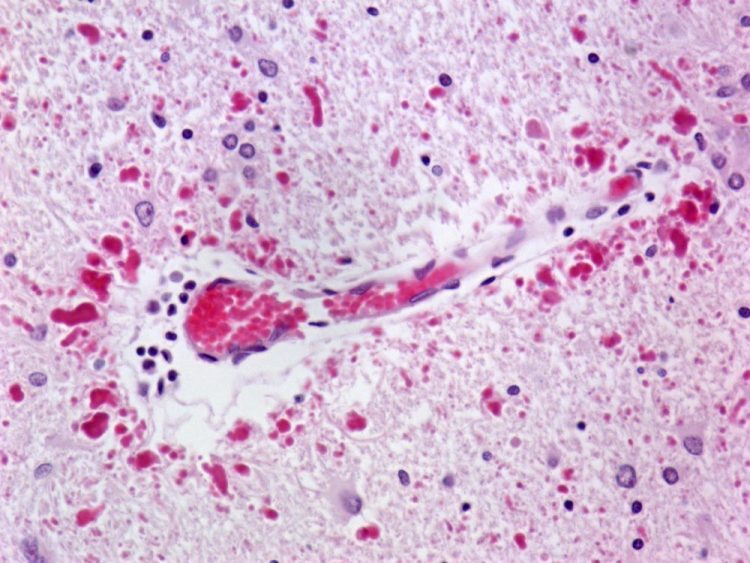Tracing a path toward neuronal cell death

Standard histology H&E staining of tissue from an eight-year-old Alexander disease patient. Rosenthal fibers -- the hallmark of the disease -- are shown in pink; nuclei are shown in blue. Image courtesy of Liqun Wang, Feany lab
Damage to astrocytes – star-shaped cells found in the brain and spinal cord – is found in many neurodegenerative conditions, but it's been unclear exactly what role astrocyte dysfunction plays in the development of disease.
Researchers at Brigham and Women's Hospital (BWH) have developed a genetic model that is yielding new insights into what happens when astrocytes go awry.
The research team developed a fruit fly model of Alexander disease, a neurodegenerative disease that primarily affects astrocytes, and was able to narrow in on the molecular signals leading to neuronal cell death, identifying nitric oxide (NO) as a critical mediator.
The team verified their results in a mouse model and also found evidence of activation of the same pathway in samples from patients with Alexander disease.
“We're excited to be contributing to a growing area of study of how astrocytes contribute to neurodegeneration, and to have uncovered a role for NO as a neuronal cell death signaling molecule,” said corresponding author Mel B. Feany, MD, PhD, a senior pathologist in the BWH Department of Pathology.
“Our findings define a potential mechanism for neuronal cell death in Alexander disease and possibly other neurodegenerative diseases with astrocyte dysfunction.”
Media Contact
All latest news from the category: Life Sciences and Chemistry
Articles and reports from the Life Sciences and chemistry area deal with applied and basic research into modern biology, chemistry and human medicine.
Valuable information can be found on a range of life sciences fields including bacteriology, biochemistry, bionics, bioinformatics, biophysics, biotechnology, genetics, geobotany, human biology, marine biology, microbiology, molecular biology, cellular biology, zoology, bioinorganic chemistry, microchemistry and environmental chemistry.
Newest articles

High-energy-density aqueous battery based on halogen multi-electron transfer
Traditional non-aqueous lithium-ion batteries have a high energy density, but their safety is compromised due to the flammable organic electrolytes they utilize. Aqueous batteries use water as the solvent for…

First-ever combined heart pump and pig kidney transplant
…gives new hope to patient with terminal illness. Surgeons at NYU Langone Health performed the first-ever combined mechanical heart pump and gene-edited pig kidney transplant surgery in a 54-year-old woman…

Biophysics: Testing how well biomarkers work
LMU researchers have developed a method to determine how reliably target proteins can be labeled using super-resolution fluorescence microscopy. Modern microscopy techniques make it possible to examine the inner workings…





















